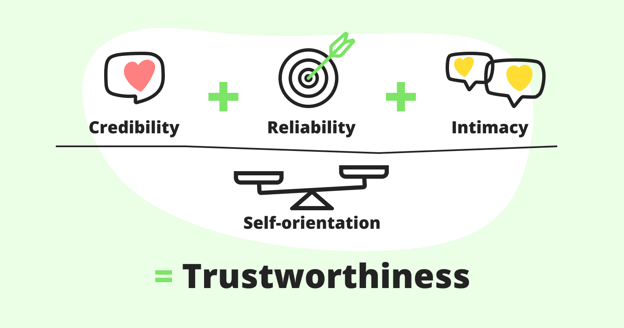When we collaborate with others on projects, it’s essential to build trust. But how can we proactively measure and increase our trustworthiness? Cue: the Trust Equation.
Everything from asking people for help or their feedback, to relying on a teammate to meet a deadline is a sign of trust. Collaboration, integrity, and innovation are built on it.
Too abstract of a concept to unpack? In this article, we take a deeper look into Charles H Green's Trust Equation, which illustrates distinct aspects of trustworthiness and gives us insight into what makes a person trustworthy. With the Trust Equation, you’ll learn how to examine the levels of reliability in your workplace relationships.
You can use the Trust Equation to assess why people may not trust you, and why you may not trust others. This looks more complicated than it is, so stick with me. It’ll help you.
Many models evaluate and determine how someone is trusted. Let’s take a look at this particular one—the Trust Equation.
The Trust Equation provides a straightforward formula for measuring trustworthiness. But a relationship has two halves. That’s only one-half of the trust mix because you’ll need to trust another person (be trusting) to establish genuine two-way trust. Let’s get to it!

T = Trustworthiness (the willingness or ability to rely on others)
C = Perception of Credibility (trusting what someone says)
R = Perception of Reliability (trusting what someone does)
I = Intimacy (entrusting someone with something)
S = Perception of Self-Orientation (self-awareness and focus, i.e., whether your focus is primarily on yourself or others).
So what does it mean to be trustworthy? Credibility, reliability, intimacy, and self-orientation are the four factors of trustworthiness. Let’s dissect each element in the section below:
How well does someone knows things? When we think of a professor, we assume that they’re competent in their subject matter. Credibility refers to how capable we think someone is, including how much confidence they give us in completing specific tasks or whether their relevant credentials reflect their knowledge in a particular area.
High credibility typically boosts an individual’s trustworthiness.
When it comes to actions and how much we trust someone to commit to what they say, that’s reliability. A track record of consistency helps boost reliability, and transparent environments help reflect this better.
When reliability is high, trustworthiness goes up as well.
Do you share doubts and negative thoughts with your team? Intimacy means feeling emotionally secure that whoever you entrust will safely handle your vulnerability and empathize with your feelings. A workplace that focuses on building psychological safety will help connect individuals and build intimacy.
A high amount of intimacy increases a person’s trustworthiness.
How much do you put yourself in front of others, especially in a team setting? Self-orientation describes this question. Caring for and paying attention to others displays a low self-orientation, whereas selfishness and only looking out for yourself signifies a high self-orientation.
As the only denominator in the equation, self-orientation works opposite to the other factors in the equation’s numerator portion. When self-orientation is high, trustworthiness tends to decrease.
Here’s an example scenario and how to use the trust equation:
I’ve just started working with Ted for the first time. After a few weeks, my impression of Ted is that he’s smart, well-informed, and punctual. However, I don’t know him that well, and he doesn’t seem to listen to others or take their ideas on board truly. Plus, he interrupts a lot. Here’s how I would rate my trust in him (from 1-10):
Credibility = 8/10
Reliability = 7/10
Intimacy = 5/10
Self Orientation = 8/10
Trust = 8 + 7 + 5/ 8 = 2.5
(Note: the highest number you can get here is 30.)
Although I believe Ted knows his stuff, meets deadlines, and I think I can trust him with what I say, my overall trust in him is low. This is because he doesn’t take my ideas on board. He doesn’t even listen to them. His disregard for me means I’m not able to build emotional trust with him.
Now, let’s make a quick comparison with my long-standing colleague, Donna. She’s equally intelligent and well-informed, sometimes late with deadlines, keeps my sensitive information confidential, and is highly aware of others and their challenges. Here’s how I would rate her:
Credibility = 8
Reliability = 5
Intimacy = 7
Self Orientation = 2
Trust = 8 + 5 + 7/ 2 = 10
Even though Donna is sometimes late with deadlines, I trust her four times more than Ted. This higher level of trust is because Donna’s Self-Orientation is low. She listens to me. She seems to care. She’s self-aware and aware of others; their feelings, thoughts, and challenges.
After looking at this equation, it becomes clear that you can increase Credibility, Reliability, and Intimacy and reduce Self-Orientation to build trust. As Charles Green states, “Self-orientation, which sits alone in the denominator, is the most important variable in the Trust Equation.”
Thus, improving your Self Orientation (by reducing it) has the most significant influence on how much people can develop emotional trust with you.
Hopefully, you’ve found this an informative explainer of the Trust Equation. But let's not forget that even Charles Green said his Trust Equation is purely one of the many models for us to consider. Perhaps the Trust Equation is an excellent starting point for us to self-reflect on our trustworthiness. You might also want to seek feedback from your friends and colleagues about where your strengths and weaknesses lie.
While it’s a great framework to measure trust, ultimately we should strive to show up authentically within our own teams. Happy relationship-building, and let us know if you have any other tips for building trust at work!
Read more by
Faye Wai
Jostle’s employee success platform is where everyone connects, communicates, and celebrates at work. Find out more at jostle.me. © 2009–2025 Jostle Corporation. All rights reserved.